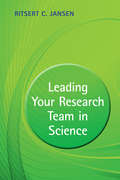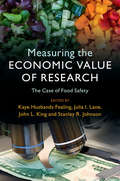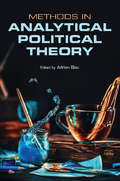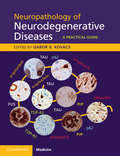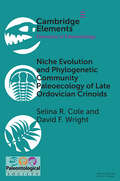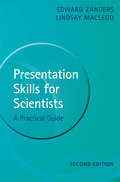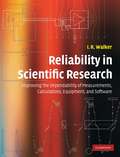- Table View
- List View
The Language of Organizational Styling
by Lionel WeeThe ways in which commercial organizations and service providers 'style' themselves - creating the image they wish to portray to their potential consumers - is a long-established area of research in the fields of sociology and business studies. However language also plays an important role in organizational styling, something which until now has been largely overlooked in the literature. This is the first book-length study of the linguistics of organizational styling, looking at the language and semiotic resources used by holiday resorts, pharmaceutical companies, restaurants and insurance companies in order to project their identities, and style themselves. It discusses in detail a number of case studies and presents an innovative take on the notion of style, as well as bringing together work from linguistics, business studies and sociology. This interdisciplinary book will be of interest to scholars and advanced students in sociolinguistics, and scholars of sociology and business studies.
Law and Language
by Harold J. Berman John Witte Jr.Completed in 1964, Harold J. Berman's long-lost tract shows how properly negotiated, translated and formalised legal language is essential to fostering peace and understanding within local and international communities. Exemplifying interdisciplinary and comparative legal scholarship long before they were fashionable, it is a fascinating prequel to Berman's monumental Law and Revolution series. It also anticipates many of the main themes of the modern movements of law, language and ethics. In his Introduction, John Witte, Jr, a student and colleague of Berman, contextualises the text within the development of Berman's legal thought and in the evolution of interdisciplinary legal studies. He has also pieced together some of the missing sections from Berman's other early writings and provided notes and critical apparatus throughout. An Afterword by Tibor Várady, another student and colleague of Berman, illustrates via modern cases the wisdom and utility of Berman's theories of law, language and community.
The Law of Reputation and Brands in the Asia Pacific
by Andrew T. Kenyon Ng-Loy Wee Loon Megan Richardson Andrew T. Kenyon Ng-Loy Wee LoonEfforts to expand the scope of legal protection given to reputation and brands in the Asia Pacific region have led to considerable controversy. Written by a variety of experts, the essays in this book consider the developing law of reputation and brands in a fraught area.
Leading your Research Team in Science
by Ritsert C. JansenTeam leaders should be full of ideas for new research projects and inspire a research group to achieve great results. This practical guide for team leaders, and those who aspire to become team leader, offers a unique approach to help readers develop research and become a more independent and productive investigator. Readers can learn how to recruit and develop talented team members, how to negotiate contracts and manage projects, and how to create wider visibility and publicity for their science. From human resources and project finances, legal affairs and knowledge transfer to public engagement and media performance, the book provides guidance to enhance skills and combine them with those of support staff on the road to success. With numerous valuable tips, real-life stories and practical exercises, this must-read guide provides everything needed to take responsibility for leading research teams. This title is available as Open Access via Cambridge Core.
Legal Publishing in Antebellum America
by M. H. HoeflichLegal Publishing in Antebellum America presents a history of the law book publishing and distribution industry in the United States. Part business history, part legal history, part history of information diffusion, M. H. Hoeflich shows how various developments in printing and bookbinding, the introduction of railroads, and the expansion of mail service contributed to the growth of the industry from an essentially local industry to a national industry. Furthermore, the book ties the spread of a particular approach to law, that is, the "scientific approach," championed by Northeastern American jurists to the growth of law publishing and law book selling and shows that the two were critically intertwined.
Measuring the Economic Value of Research: The Case Of Food Safety
by Kaye Husbands Fealing Julia I. Lane John L. King Stanley R. JohnsonThe scientific advances that underpin economic growth and human health would not be possible without research investments. Yet demonstrating the impact of research programs is a challenge, especially in areas that span disciplines, industrial sectors, and encompass both public and private sector activity. All areas of research are under pressure to demonstrate benefits from federal funding of research. This exciting and innovative study demonstrates new methods and tools to trace the impact of federal research funding on the structure of research, and the subsequent economic activities of funded researchers. The case study is food safety research, which is critical to avoiding outbreaks of disease. The authors make use of an extraordinary new data infrastructure and apply new techniques in text analysis. Focusing on the impact of US federal food safety research, this book develops vital data-intensive methodologies that have a real world application to many other scientific fields.
Methods in Analytical Political Theory
by Adrian BlauThis is the first book to explain how to use key methods in analytical political theory. The methods discussed include contractualism, reflective equilibrium, positive political theory, thought experiments and ideological analysis. Many discussions of political theory methods describe and justify these methods with little or no discussion of their application, emphasizing 'what is' and 'why do' over 'how to'. This book covers all three. Each chapter explains what kinds of problems in political theory might require researchers to use a particular method, the basic principles behind the method being proposed, and an analysis of how to apply it, including concrete principles of good practice. The book thus summarizes methodological ideas, grouped in one place and made accessible to students, and it makes innovative contributions to research methods in analytical political theory.
Modern Legal Drafting
by Peter ButtIn the second edition of this highly regarded text, the authors show how and why traditional legal language has developed the peculiar characteristics that make legal documents inaccessible to the end users. Incorporating recent research and case law, the book provides a critical examination of case law and the rules of interpretation. Detailed case studies illustrate how obtuse or outdated words, phrases and concepts can be rewritten, reworked or removed altogether. Particularly useful is the step-by-step guide to drafting in the modern style, using examples from four types of common legal documents: leases, company constitutions, wills and conveyances. Readers will gain an appreciation of the historical influences on drafting practice and the use of legal terminology. They will learn about the current moves to reform legal language, and receive clear instruction on how to make their writing clearer and their legal documents more useful.
Modern Small Antennas
by Kyohei Fujimoto Hisashi MorishitaIf you are involved in designing and developing small antennas, this complete, cutting-edge guide covers everything you need to know. From fundamentals and basic theory to design optimization, evaluation, measurements and simulation techniques, all the essential information is included. You will also get many practical examples from a range of wireless systems, whilst a glossary is provided to bring you up to speed on the latest terminology. A wide variety of small antennas is covered, and design and practice steps are described for each type: electrically small, functionally small, physically constrained small and physically small. Whether you are a professional in industry, a researcher, or a graduate student, this is your essential guide to small antennas.
Multilayer Social Networks
by Mark E. Dickison Matteo Magnani Luca RossiMultilayer networks, in particular multilayer social networks, where users belong to and interact on different networks at the same time, are an active research area in social network analysis, computer science, and physics. These networks have traditionally been studied within these separate research communities, leading to the development of several independent models and methods to deal with the same set of problems. This book unifies and consolidates existing practical and theoretical knowledge on multilayer networks including data collection and analysis, modeling, and mining of multilayer social network systems, the evolution of interconnected social networks, and dynamic processes such as information spreading. A single real dataset is used to illustrate the concepts presented throughout the book, demonstrating both the practical utility and the potential shortcomings of the various methods. Researchers from all areas of network analysis will learn new aspects and future directions of this emerging field.
Music in Context: Manuscripts and Medieval Song
by Deeming, Helen and Leach, Elizabeth Eva Helen Deeming Elizabeth Eva LeachThe manuscript sources of medieval song rarely fit the description of 'songbook' easily. Instead, they are very often mixed compilations that place songs alongside other diverse contents, and the songs themselves may be inscribed as texts alone or as verbal and musical notation. This book looks afresh at these manuscripts through ten case studies, representing key sources in Latin, French, German, and English from across Europe during the Middle Ages. Each chapter is authored by a leading expert and treats a case study in detail, including a listing of the manuscript's overall contents, a summary of its treatment in scholarship, and up-to-date bibliographical references. Drawing on recent scholarly methodologies, the contributors uncover what these books and the songs within them meant to their medieval audience and reveal a wealth of new information about the original contexts of songs both in performance and as committed to parchment.
Music Sketches
by Friedemann SallisThe term 'music sketch' relates to the vast variety of documents that are used by composers to work out a musical technique or idea and to prepare their work for performance or publication. These documents can often provide crucial insights into authorship, biography, editorial practice and musical analysis. This Introduction provides students and scholars with the knowledge and skills they need to embark on research projects involving the study of composers' working documents. Presenting examples of the compositional process over a 400-year period, it includes a selection of detailed case studies on how sketches were created and the techniques that were used, such as transcription and the sorting of loose leaves. Numerous illustrations of manuscripts and autographs, many of which have never been published before, show how these vital documents can be used to better understand the compositional processes of the seventeenth and eighteenth centuries.
Natural Categories and Human Kinds
by Muhammad Ali KhalidiThe notion of 'natural kinds' has been central to contemporary discussions of metaphysics and philosophy of science. Although explicitly articulated by nineteenth-century philosophers like Mill, Whewell and Venn, it has a much older history dating back to Plato and Aristotle. In recent years, essentialism has been the dominant account of natural kinds among philosophers, but the essentialist view has encountered resistance, especially among naturalist metaphysicians and philosophers of science. Informed by detailed examination of classification in the natural and social sciences, this book argues against essentialism and for a naturalist account of natural kinds. By looking at case studies drawn from diverse scientific disciplines, from fluid mechanics to virology and polymer science to psychiatry, the author argues that natural kinds are nodes in causal networks. On the basis of this account, he maintains that there can be natural kinds in the social sciences as well as the natural sciences.
Neuropathology of Neurodegenerative Diseases
by Gabor G. KovacsThis practical guide to the diagnosis of neurodegenerative diseases discusses modern molecular techniques, morphological classification, fundamentals of clinical symptomology, diagnostic pitfalls and immunostaining protocols. It is based on the proteinopathy concept of neurodegenerative disease, which has influenced classification and provides new strategies for therapy. Numerous high-quality images, including histopathology photomicrographs and neuroradiology scans, accompany the description of morphologic alterations and interpretation of immunoreactivities. Diagnostic methods and criteria are placed within recent developments in neuropathology, including the now widespread application of immunohistochemistry. To aid daily practice, the guide includes diagnostic algorithms and offers personal insights from experienced experts in the field. Special focus is given to the way brain tissue should be handled during diagnosis. This is a must-have reference for medical specialists and specialist medical trainees in the fields of pathology, neuropathology and neurology working with neuropathologic features of neurodegenerative diseases.
Niche Evolution and Phylogenetic Community Paleoecology of Late Ordovician Crinoids (Elements of Paleontology)
by Selina R. Cole David F. WrightFossil crinoids are exceptionally suited to deep-time studies of community paleoecology and niche partitioning. By merging ecomorphological trait and phylogenetic data, this Element summarizes niche occupation and community paleoecology of crinoids from the Bromide fauna of Oklahoma (Sandbian, Upper Ordovician). Patterns of community structure and niche evolution are evaluated over a ~5 million-year period through comparison with the Brechin Lagerstätte (Katian, Upper Ordovician). The authors establish filtration fan density, food size selectivity, and body size as major axes defining niche differentiation, and niche occupation is strongly controlled by phylogeny. Ecological strategies were relatively static over the study interval at high taxonomic scales, but niche differentiation and specialization increased in most subclades. Changes in disparity and species richness indicate the transition between the early-middle Paleozoic Crinoid Evolutionary Faunas was already underway by the Katian due to ecological drivers and was not triggered by the Late Ordovician mass extinction.
Phase Theory
by Barbara CitkoPhase Theory is the latest empirical and conceptual innovation in syntactic theory within the Chomskyan generative tradition. Adopting a cross-linguistic perspective, this book provides an introduction to Phase Theory, tracing the development of phases in minimalist syntax. It reviews both empirical and theoretical arguments in favor of phases, and examines the role phases play at the interface with semantics and phonology. Analyzing current phasehood diagnostics, it applies them in a systematic fashion to a broad range of syntactic categories, both phases and non-phases. It concludes with a discussion of some of the more contentious issues in Phase Theory, involving cross-linguistic variation with respect to phasehood and the dynamic versus static nature of phases.
Play in the Early Years
by Marilyn FleerThe Early Years Learning Framework is a key component of the Australian Government's National Quality Framework for early childhood education and care. Play-based learning is an important focus in both the Framework and in early childhood education degrees at Australian universities. Play in the Early Years is a comprehensive study of pedagogy and play in early childhood education by a globally recognised leader in the field. Marilyn Fleer examines how play has been thought about across time, culture and institutions, including in childcare, family day care, schools and community groups. The book presents and analyses the latest research and theories about early childhood pedagogy and play. Vignettes and real-world examples help students connect theory to practice, while end-of-chapter glossaries help to consolidate understanding of key concepts and ideas. This is an accessible and engaging textbook that will be an invaluable resource for practitioners and undergraduate students of early childhood education.
Presentation Skills for Scientists: A Practical Guide
by Edward Zanders Lindsay MacLeodIt is now widely recognised that professional presentation skills are an indispensable cornerstone of a successful scientific career. This updated second edition provides a concise and accessible guide to preparing and delivering scientific presentations. Its highly practical 'how-to' style focuses on the issues that are of immediate concern to the busy scientist. The text covers all of the important aspects of scientific presentations, including knowing your audience, producing visual material, controlling nerves and handling questions. It also includes advice on presenting in English for non-native speakers, helping them to improve the clarity and effectiveness of their presentations. Links are included throughout the text to the accompanying website, which contains annotated video clips of speakers delivering a talk and demonstrates the common problems encountered, as well as exercises designed to overcome them. It also contains image files to demonstrate the design issues to consider when creating visual material.
Privacy and Power
by Miller Russell A.Edward Snowden's leaks exposed fundamental differences in the ways Americans and Europeans approach the issues of privacy and intelligence gathering. Featuring commentary from leading commentators, scholars and practitioners from both sides of the Atlantic, the book documents and explains these differences, summarized in these terms: Europeans should 'grow up' and Americans should 'obey the law'. The book starts with a collection of chapters acknowledging that Snowden's revelations require us to rethink prevailing theories concerning privacy and intelligence gathering, explaining the differences and uncertainty regarding those aspects. An impressive range of experts reflect on the law and policy of the NSA-Affair, documenting its fundamentally transnational dimension, which is the real location of the transatlantic dialogue on privacy and intelligence gathering. The conclusive chapters explain the dramatic transatlantic differences that emerged from the NSA-Affair with a collection of comparative cultural commentary.
Privacy, Big Data, and the Public Good
by Julia Lane Victoria Stodden Stefan Bender Helen Nissenbaum Julia Lane Victoria Stodden Stefan BenderMassive amounts of data on human beings can now be analyzed. Pragmatic purposes abound, including selling goods and services, winning political campaigns, and identifying possible terrorists. Yet 'big data' can also be harnessed to serve the public good: scientists can use big data to do research that improves the lives of human beings, improves government services, and reduces taxpayer costs. In order to achieve this goal, researchers must have access to this data - raising important privacy questions. What are the ethical and legal requirements? What are the rules of engagement? What are the best ways to provide access while also protecting confidentiality? Are there reasonable mechanisms to compensate citizens for privacy loss? The goal of this book is to answer some of these questions. The book's authors paint an intellectual landscape that includes legal, economic, and statistical frameworks. The authors also identify new practical approaches that simultaneously maximize the utility of data access while minimizing information risk.
The Psychologist’s Companion
by Sternberg Robert J. Karin SternbergThe Psychologist's Companion is intended for students as well as young professionals and writers at all stages of their careers seeking inspiration and guidelines for better scientific writing. This book is also a resource for researchers in related fields. It has been comprehensively updated, revised, and extended for its fifth edition and includes the latest style guidelines of the American Psychological Association's Publication Manual (sixth edition, 2009) as well as chapters encompassing the entire research process from doing literature research and planning an experiment to writing the paper. It features new chapters on literature research; ethics; and generating, evaluating, and selling ideas. The Psychologist's Companion also provides information on writing book proposals, grant proposals, and lectures.
The Psychologist's Companion
by Robert J. Sternberg Karin SternbergThe Psychologist's Companion is intended for students as well as young professionals and writers at all stages of their careers seeking inspiration and guidelines for better scientific writing. This book is also a resource for researchers in related fields. It has been comprehensively updated, revised, and extended for its fifth edition and includes the latest style guidelines of the American Psychological Association's Publication Manual (sixth edition, 2009) as well as chapters encompassing the entire research process from doing literature research and planning an experiment to writing the paper. It features new chapters on literature research; ethics; and generating, evaluating, and selling ideas. The Psychologist's Companion also provides information on writing book proposals, grant proposals, and lectures.
Reliability in Scientific Research
by I. R. WalkerClinical Manual of Emergency Pediatrics, 5th edition, is a concise, portable handbook summarizing the wide range of conditions encountered in pediatric emergency departments. As children with acute problems often receive care in private offices and clinics, it is equally relevant for pediatricians, emergency medicine physicians, family practitioners and internists. The 5th edition of this hugely successful resource is the leading book of its kind for several reasons: - Clear, concise guidance is given for patient evaluation and follow-up and explicit indications for admission - Every chapter is organized in a standard format, making it very easy for a reader to locate critical information rapidly - A dedicated 'Special Considerations' chapter addresses difficult problems such as the crying infant and the cross-cultural encounter Numerous new topics are included, making Clinical Manual of Emergency Pediatrics, 5th edition an invaluable resource for any physician working in acute care settings where children are seen.
Reliability in Scientific Research
by I. R. WalkerCovering many techniques widely used in research, this book will help researchers in the physical sciences and engineering solve troublesome - and potentially very time consuming - problems in their work. The book deals with technical difficulties that often arise unexpectedly during the use of various common experimental methods, as well as with human error. It provides preventive measures and solutions for such problems, thereby saving valuable time for researchers. Some of the topics covered are: sudden leaks in vacuum systems, electromagnetic interference in electronic instruments, vibrations in sensitive equipment, and bugs in computer software. The book also discusses mistakes in mathematical calculations, and pitfalls in designing and carrying out experiments. Each chapter contains a summary of its key points, to give a quick overview of important potential problems and their solutions in a given area.
Research Ethics:
by Gary ComstockEducation in the responsible conduct of research typically takes the form of online instructions about rules, regulations, and policies. Research Ethics takes a novel approach and emphasizes the art of philosophical decision-making. Part A introduces egoism and explains that it is in the individuals own interest to avoid misconduct, fabrication of data, plagiarism and bias. Part B explains contractualism and covers issues of authorship, peer review and responsible use of statistics. Part C introduces moral rights as the basis of informed consent, the use of humans in research, mentoring, intellectual property and conflicts of interests. Part D uses two-level utilitarianism to explore the possibilities and limits of the experimental use of animals, duties to the environment and future generations, and the social responsibilities of researchers. This book represents a fresh approach to research ethics. It will engage the moral imaginations of graduate students in all disciplines.

